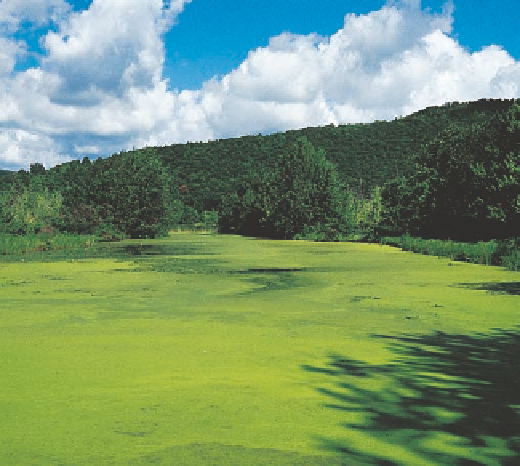Environmental Engineering Reference
In-Depth Information
(Figure 5-35, p. 105) that undergo little vertical mixing.
Second,
they have little flow. The flushing and chang-
ing of water in lakes and large artificial reservoirs can
take from 1 to 100 years, compared with several days
to several weeks for streams.
As a result, lakes and reservoirs are more vulnera-
ble than streams to contamination by runoff or dis-
charge of plant nutrients, oil, pesticides, and toxic sub-
stances such as lead, mercury, and selenium. These
contaminants can kill bottom life and fish and birds
that feed on contaminated aquatic organisms. Many
toxic chemicals and acids also enter lakes and reser-
voirs from the atmosphere.
lake, a process called
cultural eutrophication.
Nitrate-
and phosphate-containing effluents mostly cause this
change. They come from sources such as runoff from
farmland, animal feedlots, urban areas, and mining
sites, and from the discharge of treated and untreated
municipal sewage. Some nitrogen also reaches lakes
by deposition from the atmosphere.
During hot weather or drought, this nutrient over-
load produces dense growths or “blooms” of organ-
isms such as algae and cyanobacteria (Figure 11-25,
right) and thick growths of water hyacinth, duckweed,
and other aquatic plants. These dense colonies of plant
life can reduce lake productivity and fish growth by
decreasing the input of solar energy needed for photo-
synthesis by the phytoplankton that support fish.
In addition, when the algae die, their decomposi-
tion by swelling populations of aerobic bacteria de-
pletes dissolved oxygen in the surface layer of water
near the shore and in the bottom layer. This oxygen de-
pletion can kill fish and other aerobic aquatic animals.
If excess nutrients continue to flow into a lake, anaero-
bic bacteria will take over and produce gaseous de-
composition products such as smelly, highly toxic
hydrogen sulfide and flammable methane.
According to the U.S. Environmental Protection
Agency (EPA), one-third of the 100,000 medium to
large lakes and 85% of the large lakes near major pop-
ulation centers in the United States have some degree
of cultural eutrophication. One-fourth of the lakes in
China also suffer from cultural eutrophication.
Science: Cultural Eutrophication
Various human activities can overload lakes with
plant nutrients, which decrease dissolved oxygen
and kill some aquatic species.
Eutrophication
is the name given to the natural nutri-
ent enrichment of lakes, mostly from runoff of plant
nutrients such as nitrates and phosphates from sur-
rounding land. An
oligotrophic lake
is low in nutrients
and its water is clear (Figure 11-25, left). Over time,
some oligotrophic lakes become more eutrophic as nu-
trients are added from the surrounding watershed and
the atmosphere. Others do not because of differences
in the surrounding drainage basin.
Near urban or agricultural areas, human activities
can greatly accelerate the input of plant nutrients to a
Figure 11-25
Natural capital degradation:
the effect of nutrient enrichment on a lake. Crater Lake in Oregon
(left) is an
oligotrophic lake;
it is low in nutrients. Because of the low density of plankton, its water is quite clear.
The lake on the right, found in western New York, is a
eutrophic lake.
Because of an excess of plant nutrients,
its surface is covered with mats of algae and cyanobacteria.




